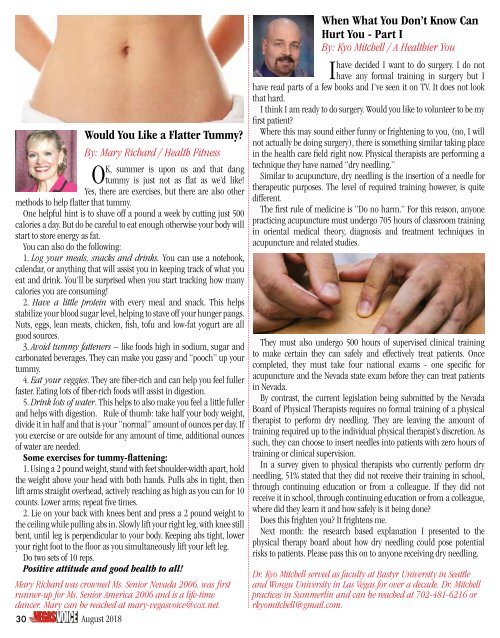Create successful ePaper yourself
Turn your PDF publications into a flip-book with our unique Google optimized e-Paper software.
Would You Like a Flatter Tummy?<br />
By: Mary Richard / Health Fitness<br />
OK, summer is upon us and that dang<br />
tummy is just not as flat as we’d like!<br />
Yes, there are exercises, but there are also other<br />
methods to help flatter that tummy.<br />
One helpful hint is to shave off a pound a week by cutting just 500<br />
calories a day. But do be careful to eat enough otherwise your body will<br />
start to store energy as fat.<br />
You can also do the following:<br />
1. Log your meals, snacks and drinks. You can use a notebook,<br />
calendar, or anything that will assist you in keeping track of what you<br />
eat and drink. You’ll be surprised when you start tracking how many<br />
calories you are consuming!<br />
2. Have a little protein with every meal and snack. This helps<br />
stabilize your blood sugar level, helping to stave off your hunger pangs.<br />
Nuts, eggs, lean meats, chicken, fish, tofu and low-fat yogurt are all<br />
good sources.<br />
3. Avoid tummy fatteners – like foods high in sodium, sugar and<br />
carbonated beverages. They can make you gassy and “pooch” up your<br />
tummy.<br />
4. Eat your veggies. They are fiber-rich and can help you feel fuller<br />
faster. Eating lots of fiber-rich foods will assist in digestion.<br />
5. Drink lots of water. This helps to also make you feel a little fuller<br />
and helps with digestion. Rule of thumb: take half your body weight,<br />
divide it in half and that is your “normal” amount of ounces per day. If<br />
you exercise or are outside for any amount of time, additional ounces<br />
of water are needed.<br />
Some exercises for tummy-flattening:<br />
1. Using a 2 pound weight, stand with feet shoulder-width apart, hold<br />
the weight above your head with both hands. Pulls abs in tight, then<br />
lift arms straight overhead, actively reaching as high as you can for 10<br />
counts. Lower arms; repeat five times.<br />
2. Lie on your back with knees bent and press a 2 pound weight to<br />
the ceiling while pulling abs in. Slowly lift your right leg, with knee still<br />
bent, until leg is perpendicular to your body. Keeping abs tight, lower<br />
your right foot to the floor as you simultaneously lift your left leg.<br />
Do two sets of 10 reps.<br />
Positive attitude and good health to all!<br />
Mary Richard was crowned Ms. Senior Nevada 2006, was first<br />
runner-up for Ms. Senior America 2006 and is a life-time<br />
dancer. Mary can be reached at mary-vegasvoice@cox.net.<br />
30<br />
August 2018<br />
When What You Don’t Know Can<br />
Hurt You - Part I<br />
By: Kyo Mitchell / A Healthier You<br />
have decided I want to do surgery. I do not<br />
I have any formal training in surgery but I<br />
have read parts of a few books and I’ve seen it on TV. It does not look<br />
that hard.<br />
I think I am ready to do surgery. Would you like to volunteer to be my<br />
first patient?<br />
Where this may sound either funny or frightening to you, (no, I will<br />
not actually be doing surgery), there is something similar taking place<br />
in the health care field right now. Physical therapists are performing a<br />
technique they have named “dry needling.”<br />
Similar to acupuncture, dry needling is the insertion of a needle for<br />
therapeutic purposes. The level of required training however, is quite<br />
different.<br />
The first rule of medicine is “Do no harm.” For this reason, anyone<br />
practicing acupuncture must undergo 705 hours of classroom training<br />
in oriental medical theory, diagnosis and treatment techniques in<br />
acupuncture and related studies.<br />
They must also undergo 500 hours of supervised clinical training<br />
to make certain they can safely and effectively treat patients. Once<br />
completed, they must take four national exams - one specific for<br />
acupuncture and the Nevada state exam before they can treat patients<br />
in Nevada.<br />
By contrast, the current legislation being submitted by the Nevada<br />
Board of Physical Therapists requires no formal training of a physical<br />
therapist to perform dry needling. They are leaving the amount of<br />
training required up to the individual physical therapist’s discretion. As<br />
such, they can choose to insert needles into patients with zero hours of<br />
training or clinical supervision.<br />
In a survey given to physical therapists who currently perform dry<br />
needling, 51% stated that they did not receive their training in school,<br />
through continuing education or from a colleague. If they did not<br />
receive it in school, through continuing education or from a colleague,<br />
where did they learn it and how safely is it being done?<br />
Does this frighten you? It frightens me.<br />
Next month: the research based explanation I presented to the<br />
physical therapy board about how dry needling could pose potential<br />
risks to patients. Please pass this on to anyone receiving dry needling.<br />
Dr. Kyo Mitchell served as faculty at Bastyr University in Seattle<br />
and Wongu University in Las Vegas for over a decade. Dr. Mitchell<br />
practices in Summerlin and can be reached at 702-481-6216 or<br />
rkyomitchell@gmail.com.

















